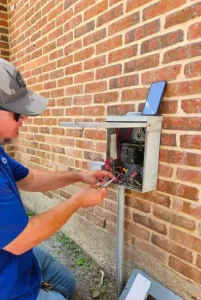Hazards of Mixing Electricity and Swimming Pools

There are many known hazards inherent in mishandling electricity, especially when switches and safety equipment and well-informed technicians are the only things standing between electrical current and swimming pool users. If many things fail at once, and sometimes if only one or two things fail, a swimmer can experience electrical shock or death by electrocution. Water is a good conductor of electricity, and electrical current can potentially enter the water by way of faulty light fixtures or by improper bonding of metal objects adjacent to swimming pools. Also, miswiring by untrained repair personnel can damage expensive pool equipment; in scenarios where equipment isn’t damaged, there are still costs associated with finding and correcting the issue. When someone fails to comply with National Electrical Code (NEC) regulations regarding minimum wiring types or sizes or amperage ratings, electrical current can create excessive heat that can melt wires, melt plastic conduit or breakers, and cause fires.
There are electricians (or folks claiming to be such) in the local area who do not understand simple truths about wiring safety devices. For instance, one cannot wire more than one ground fault circuit interrupter (GFCI) in series without causing a false trip and eventually ruining one of the GFCI devices (“in series” meaning to wire the line terminals of a GFCI device off of the load – protected – terminals of another GFCI device). There are others working at homes in North Dallas who have not kept 240-volt circuits in parallel between their breakers and the point of use; mixing one leg of one breaker with a leg of another prevents equipment from working (best case scenario) or causes damage that can lead to dangerous situations for pool owners and repair technicians. Some licensed electricians tell homeowners, “I don’t do pools,” even though electricity and the codes by which we regulate it are the same no matter where you apply them.
Energy is all around us, and much of it is electromagnetic. Thus, the potential for shock or electrocution exists as cloud-to-ground lightning, uncontrolled current from electrical devices, and even the tiny, naturally-occurring electrical currents found in all metallic substances. If restricted to a narrow, confined area of conductive material (such as the steel support grid in a pool’s structure), the buildup of electrical energy can send current into the best nearby conductors – water and human bodies. Because of this, the NEC requires pools to be bonded properly, with an 8-gauge bare copper wire, in order to cause electrical currents to dissipate across a broader conductive pathway, leading safely to the ground or back to the source. This must be done for new pools, as well as for pools where metallic features are added near the water. Also, if one disturbs the bond wire (such as in a deck replacement), a new bonding loop must be installed. A customer of Select Pool Services once felt current as he swam near his pool light, supposedly even when the light was not on. The light was grounded, but our electricians concluded the pool had no bond wire.
A ground fault circuit interrupter (GFCI) is meant to protect swimmers by breaking the circuit to a fixture if it senses a drop in voltage. When these devices fail, they most often fail in the worst position – stuck allowing current to pass constantly. Whether for pool/spa lights or in a wet location inside the house, they should be tested monthly. When a GFCI is working correctly, it will trip – interrupt power – when a faulty appliance is connected or plugged into the receptacle. Learn about pool lights and protective measures here.
